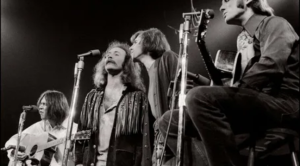
Crosby, Stills, Nash & Young – Carry On: A Song of Hope and Perseverance
In the annals of rock and roll history, Crosby, Stills, Nash & Young stand as a towering ensemble, their music weaving a tapestry of intricate harmonies, poignant lyrics, and genre-bending experimentation. Among their vast repertoire, “Carry On” holds a special place, a stirring anthem that has resonated with listeners for generations, offering a message of hope and perseverance amidst life’s challenges.
Background
Released in 1970 as the opening track of their album Déjà Vu, “Carry On” marked a turning point in the band’s dynamic. The group, known for their internal conflicts and creative clashes, found common ground in this song, creating a masterpiece that encapsulated their collective spirit and artistry.
The song opens with a gentle acoustic guitar strumming, setting the stage for Stephen Stills’s soaring vocals. His lyrics paint a vivid picture of uncertainty and doubt, as he sings, “We are the fortunes of faes / A nowness quickness with which / We sing the blues you got / To carry on.”
The chorus, a beacon of hope amidst the melancholic verses, proclaims, “Carry on, carry on / Though the skies are gray / Carry on, carry on / It’s a brand new day.” The repetition of the phrase “carry on” serves as a mantra, urging listeners to persevere through adversity and embrace the promise of a brighter future.
Neil Young’s harmonica solo adds a layer of raw emotion to the song, his soulful notes echoing the protagonist’s inner struggles and determination. The interplay of Stills’s vocals and Young’s harmonica creates a powerful synergy, capturing the essence of the song’s message.
“Carry On” has become a staple of Crosby, Stills, Nash & Young’s live performances, often serving as a closing anthem that leaves audiences feeling uplifted and inspired. The song’s enduring popularity lies in its ability to connect with listeners on a personal level, offering solace and encouragement in the face of life’s challenges.
Beyond its musical impact, “Carry On” has taken on a broader cultural significance. The song has been used in numerous films and television shows, its message of hope and perseverance resonating with audiences worldwide. It has also been adopted by various social movements, its lyrics serving as a rallying cry for those fighting for change.
Video
Here are some additional details about the song:
- The song was written by Stephen Stills.
- It was released in 1970 as the opening track of Crosby, Stills, Nash & Young’s album Déjà Vu.
- The song has been covered by numerous artists, including John Mayer, Neil Diamond, and Adele.
- “Carry On” has been used in numerous films and television shows, including The Karate Kid and The West Wing.